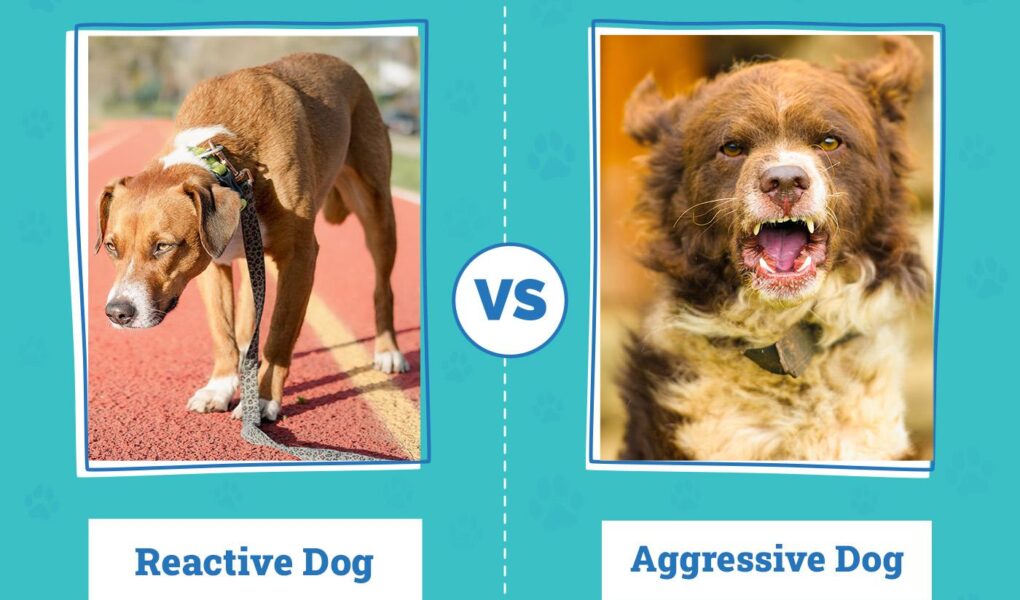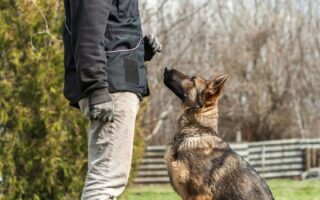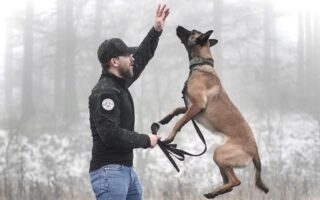Introduction: Understanding the Reactive Canine
In the heart of every dog owner lies a desire for connection, companionship, and trust. However, for those who share their lives with reactive dogs—those furry companions who respond with intense emotions to certain triggers—this bond can sometimes feel strained. Whether it’s the bark of a passing squirrel, the laughter of excited children, or the approach of another dog, reactivity can manifest in various ways, from barking and lunging to hiding and trembling. But fear not! Understanding and managing this behavior is within reach. In this article, we’ll explore effective training techniques tailored for reactive dogs, shedding light on the underlying causes of reactivity, the importance of patience, and the transformative power of positive reinforcement. Join us on this journey as we uncover practical strategies that not only improve behavior but also foster patience, trust, and a deeper connection between you and your beloved canine companion.
Table of Contents
- Understanding Reactivity in Dogs and Its Triggers
- Building a Trustworthy Foundation: The Role of Positive Reinforcement
- Effective Techniques for Managing Reactive Behavior in Various Environments
- Creating a Structured Training Plan: Consistency and Patience are Key
- Q&A
- To Wrap It Up
Understanding Reactivity in Dogs and Its Triggers
Understanding the nuances of reactivity in dogs is essential for effective training. Reactivity often stems from a variety of triggers that can provoke an intense response, including:
- Other Dogs: Canines might react out of fear, frustration, or territorial defense.
- Strangers: Unfamiliar people approaching can elicit anxiety or a protective reaction.
- Unexpected Noises: Loud sounds or sudden movements can startle a dog, prompting defensiveness.
- New Environments: Changes in surroundings can cause stress and provoke a heightened state of alert.
Recognizing these triggers is the first step in helping your dog cope with their environment. To address reactivity effectively, consider implementing strategies such as gradual desensitization and counter-conditioning. A structured approach may include:
| Strategy | Description |
|---|---|
| Desensitization | Gradually exposing your dog to triggers at a distance where they remain calm. |
| Counter-conditioning | Pairing a positive experience (like treats) with the presence of the trigger. |
| Training Commands | Teaching commands like “sit” or “look” to redirect their attention. |
Building a Trustworthy Foundation: The Role of Positive Reinforcement
In the journey of training a reactive dog, establishing a reliable bond based on trust is essential. Utilizing positive reinforcement not only builds this foundation but also fosters a sense of safety for the dog. When a dog learns to associate specific behaviors with positive outcomes, such as treats, praise, or playtime, it encourages them to repeat those behaviors. This approach helps to alleviate anxiety and fear, common triggers for reactivity. Instead of punishing unwanted behavior, rewarding desirable actions creates a more harmonious training environment.
Implementing positive reinforcement requires consistency and patience. Create a clear set of desired behaviors that you aim to reinforce, and be ready to recognize them immediately as they occur. Some effective strategies include:
- Using high-value treats to reward calm behavior in the presence of triggers.
- Incorporating interactive toys during training sessions to maintain engagement.
- Practicing relaxed leash walking to combat excitement and promote calmness.
Below is a simple reference table that outlines effective reinforcement techniques along with their corresponding benefits:
| Technique | Benefit |
|---|---|
| Clicker Training | Promotes clear communication |
| Praise and Petting | Strengthens emotional bond |
| Treat Dispensing Toys | Encourages independent play |
Effective Techniques for Managing Reactive Behavior in Various Environments
Managing reactive behavior in dogs requires understanding their triggers and implementing consistent strategies tailored to different environments. One effective technique is desensitization, which involves gradually exposing the dog to their triggers at a distance where they feel safe, followed by rewarding calm behavior. This exposure can occur in controlled settings, such as a quiet park or even inside your home. Over time, increase the proximity to the trigger, always ensuring the dog remains calm and is positively reinforced. This method helps to reduce the dog’s sensitivity to stimuli that previously caused reactivity.
Another approach is counter-conditioning, where the aim is to change the dog’s emotional response to a trigger. To do this effectively, create positive associations by pairing triggers with high-value rewards. For instance, if your dog becomes reactive upon seeing other dogs, reward them with treats or praise when they observe another dog from a distance without reacting. Ensure to work with manageable distances and gradually decrease the space as their comfort level increases. Additionally, employing consistency in commands and routines can help the dog feel more secure across different environments.
| Technique | Description | Benefits |
|---|---|---|
| Desensitization | Gradually exposing the dog to triggers at a safe distance. | Helps dogs adapt to stimuli, reducing reactivity over time. |
| Counter-conditioning | Changing the dog’s emotional response by pairing triggers with rewards. | Creates positive associations, promoting calm behavior. |
Creating a Structured Training Plan: Consistency and Patience are Key
When working with reactive dogs, developing a structured training plan is essential to foster long-term behavioral improvements. This plan should incorporate consistent routines that provide your dog with clear expectations. Regular training sessions, lasting approximately 5-10 minutes several times a day, can reinforce positive behaviors. Utilize the following strategies to maximize your training efforts:
- Consistency: Maintain similar cues and rewards across sessions.
- Routine Reinforcement: Implement the same exercises daily to help your dog learn and adapt.
- Patience: Understand that progress takes time; celebrate small victories.
Design your training plan to include both structured exercises and spontaneous practice in a variety of environments. Transitioning from controlled settings to real-world situations will help your dog generalize learned behaviors. To further enhance your training approach, consider using a tracking table to monitor progress and identify areas needing improvement:
| Training Exercise | Duration | Notes |
|---|---|---|
| Focus Command | 5 minutes | Increase distraction level gradually |
| Leash Walking | 10 minutes | Use treats for positive reinforcement |
| Calm Space Training | 7 minutes | Encourage relaxation on cue |
Q&A
Q&A for Article: “Dog Training for Reactive Dogs”
Q: What does it mean for a dog to be reactive?
A: A reactive dog typically exhibits strong, aggressive, or fearful responses to certain triggers in their environment, such as other dogs, people, or loud noises. These reactions often stem from anxiety, fear, or frustration rather than aggression.
Q: What are the common triggers for reactive dogs?
A: Common triggers can vary widely from dog to dog, but they often include other animals, unfamiliar people, sudden movements, or specific sounds. Identifying these triggers is a crucial first step in effective training.
Q: How can I recognize if my dog is reactive?
A: Signs of reactivity can include barking, growling, lunging, or snapping. You might also notice behaviors like stiff body posture, raised hackles, or an intense stare. Subtle cues, like frequent whining or retreating, can also indicate discomfort or anxiety.
Q: What’s the first step in training a reactive dog?
A: The initial step is to assess the situation. Identify your dog’s triggers and observe their reactions. Keeping a journal of these behaviors will help you understand patterns and prepare for training sessions tailored to their specific needs.
Q: Should I consult a professional trainer?
A: Yes, working with a professional dog trainer experienced in reactive behavior can provide invaluable guidance. They can develop a customized training plan and teach you effective techniques to manage your dog’s reactions in a supportive environment.
Q: What training techniques are effective for reactive dogs?
A: Techniques like desensitization, counter-conditioning, and positive reinforcement are often effective. Gradually exposing your dog to their triggers in controlled settings while rewarding calm behavior helps them learn to respond more appropriately.
Q: How important is management alongside training?
A: Management is crucial! Avoiding triggers when possible will help prevent reactive episodes and reduce stress for both you and your dog. Consider using tools such as head halters, harnesses, or even muzzles to ensure safety during walks.
Q: What role does socialization play in addressing reactivity?
A: Socialization is key to helping your dog become more comfortable with a variety of people, dogs, and environments. Gentle introductions to well-mannered dogs in calm settings can help your dog build confidence and reduce reactivity over time.
Q: How long does it take to see improvement in a reactive dog?
A: The timeline for improvement can vary greatly among dogs. Some may show progress within weeks, while others may take months or even years. Consistency, patience, and a positive attitude are essential throughout this journey.
Q: Can I train a reactive dog on my own?
A: While it’s possible to train a reactive dog at home, guidance from a professional can significantly enhance your success. They can help you navigate challenges, offer feedback, and provide support as you embark on this rewarding journey.
Q: Are there any resources you recommend for owners of reactive dogs?
A: Absolutely! Consider books like “Feisty Fido” by Patricia McConnell or “Control Unleashed” by Leslie McDevitt. Additionally, online courses, local training classes, and support groups can offer encouragement and valuable insights.
Q: What’s the most important takeaway for owners of reactive dogs?
A: Remember, you’re not alone in this journey. With patience, understanding, and the right techniques, your reactive dog can learn to feel more comfortable and secure in their environment, ultimately leading to a happier and healthier life together.
To Wrap It Up
As we draw the curtain on our exploration of dog training for reactive companions, it’s clear that the journey toward a calmer, more balanced dog is not just a destination but a process filled with dedication, patience, and understanding. Reactive behavior in dogs can stem from a myriad of sources, but armed with the right knowledge, techniques, and strategies, you can transform those anxious outbursts into moments of confidence and composure.
Remember, every dog is unique, and what works for one may not work for another. Celebrate the small victories, lean on the support of a professional trainer if needed, and most importantly, cultivate a bond of trust and communication with your furry friend. By embracing this journey together, you not only enhance their quality of life but also enrich your own experience as a pet owner.
In the world of training, progress may come in tiny increments, but every step counts. With persistence and love, you can unlock the potential within your reactive dog and turn challenges into triumphs. Together, let’s continue to learn, adapt, and grow—because every wagging tail deserves a chance to feel safe, loved, and at home in their environment. Happy training!



